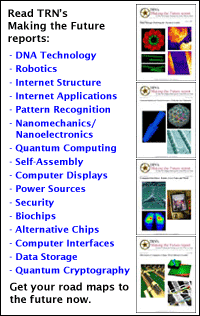
Molecule harvests water's hydrogen
By
Kimberly Patch,
Technology Research NewsThe key to producing clean hydrogen energy is finding a non-polluting method to extract pure hydrogen from its most abundant source -- water.
Researchers have been working for decades to develop catalysts that make it possible to use energy from sunlight to extract hydrogen from water. These materials absorb energy from photons in order to speed the rate at which electrons combine with hydrogen in water molecules to split water into hydrogen and oxygen.
Such catalysts are commonly made from the semiconductor materials used to make computer chips. Researchers are working to find catalysts that can extract energy from a greater portion of sunlight's spectrum and use the energy to move electrons more efficiently.
Researchers from Virginia Polytechnic and State University have developed a large molecule, or supramolecular complex, that combines sub-units that absorb light with sub-units that accept electrons.
The researchers' supramolecular complex could be used in devices that use light energy to extract hydrogen from water. "The hydrogen gas would then be used as a fuel and combusted in the presence of oxygen in air to produce water and energy, either in the form of heat for a combustion engine or electricity from a fuel cell," Karen Brewer, an associate professor of chemistry at Virginia Tech.
Plants carry out photosynthesis by absorbing photons and using their energy to generate biomass. "This is accomplished through very complex pathways in biological systems," said Brewer. Nearly all the energy we use, including oil, coal, wood, and gas, is second-hand solar energy drawn from this biomass. The researchers' artificial photosynthesis process bypasses the photosynthetic plant altogether by using light to produce fuel directly.
It has been known for years that molecules containing the metal ruthenium absorb solar light well and are capable of producing enough energy to carry out hydrogen production, said Brewer. The stumbling block to producing such molecules is getting light to generate two or more electrons at a time, which is required to generate enough energy to split water, she said.
The researchers' molecule is made up of the elements rhodium, ruthenium, chlorine, carbon, nitrogen and hydrogen.
It has light-absorbing ruthenium subunits on each end, connector sub-units near the middle, and a reactive rhodium sub-unit in the center that collects electrons and delivers them to water. "Each sub-unit in our assembly performs an individual task," said Brewer. "The assembly of these sub-units into a larger structure allows each sub-unit to perform its task and, combined with other sub-unit's tasks, [accomplish] a more complex function," she said.
Figuring out how to design, prepare and use a supramolecular complex capable of using light to collect electrons took more than a decade of work, said Brewer. "We have worked for many years on trying to understand the properties of these supramolecular complexes well enough that we would be able to design the right systems to perform this complex function," she said.
Custom-designed supramolecular complexes promise to be useful in other areas as well. "Understanding the interactions of light with complex molecular systems could have broad impact in a variety of processes that involve light energy," said Brewer.
The researchers are working on adjusting the molecular design to optimize the efficiency and long-term stability of the molecular complexes, said Brewer. "We will be... working to optimize the system to produce the best hydrogen production per amount of light absorbed [and] to absorb the solar spectrum fully."
The wavelengths in sunlight range from infrared through visible light to ultraviolet. Sunlight is about 53 percent infrared, which includes the energy, 43 percent visible light, and 4 percent ultraviolet. The researchers' supramolecular complex absorbs photons from with wavelengths from 200 to 600 nanometers, which range from the near infrared through most of the visible spectrum. A nanometer is one millionth of a millimeter.
The researchers are also working on the oxygen half of the water-splitting reaction, which could be accomplished by adding other subunits to the molecule, said Brewer. The existing molecule generates hydrogen but leaves oxygen bound to other elements of the reaction. Other subunits would complete the process by freeing the oxygen.
Brewer's research colleague was Mark Elvington. They presented the research at the 228th American Chemical Society National Meeting held in Philadelphia on August 22 through 26, 2004. The research was funded by the National Science Foundation (NSF) and the American Chemical Society.
Timeline: unknown
Funding: Government; Private
TRN Categories: Energy; Materials Science and Engineering
Story Type: News
Related Elements: None
Advertisements:
December 15/22, 2004
Page One
Light clock promises finer time
Physics model predicts book sales
Silicon ring boosts light chips
Molecule harvests water's hydrogen
Briefs:
Virtual ring eases scrolling
DNA makes nanotube transistors
Scheme simplifies quantum chips
Aligned nanotubes accommodate bone
Light writes info into atoms
See-through circuits speed up
News:
Research News Roundup
Research Watch blog
Features:
View from the High Ground Q&A
How It Works
RSS Feeds:
News
Ad links:
Buy an ad link
| Advertisements:
|
 |
Ad links: Clear History
Buy an ad link
|
TRN
Newswire and Headline Feeds for Web sites
|
© Copyright Technology Research News, LLC 2000-2006. All rights reserved.